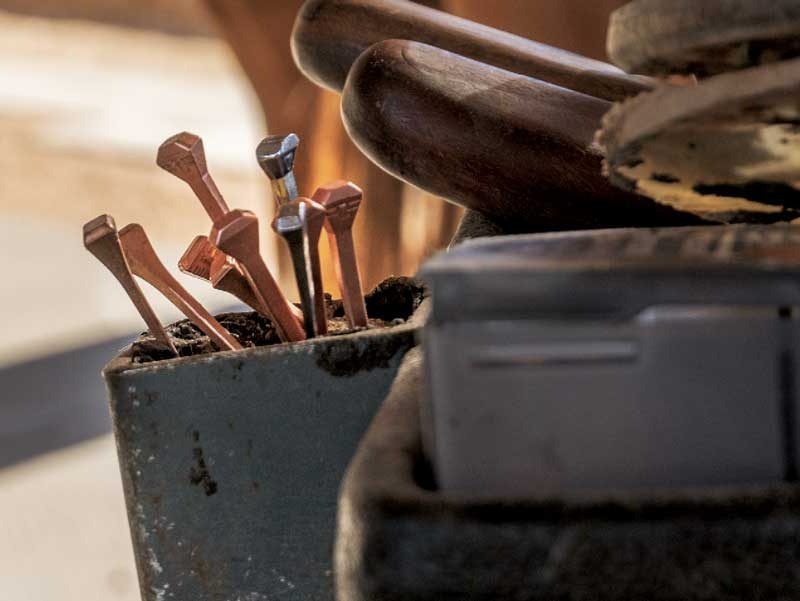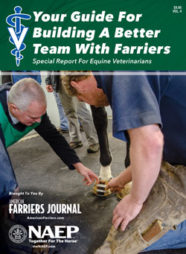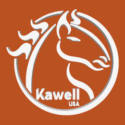Farrier Takeaways
- Clients typically have little understanding of what your expenses are, so explaining these can help them understand your rates.
- Even a seemingly insignificant cost like an individual nail adds up over a year when you consider discarded nails.
- Don’t wait until there is an objection to discuss your expenses with a client. Explain it in a proactive manner.
To build loyal customers, look for opportunities to educate your clients about footcare. This proves important when encountering clients who question the amount they pay for footcare. Rather than getting defensive, I like to provide insight. Most clients have little understanding of what it costs us to shoe their horses.
I never lost a debate with a client over pricing if I took the time to explain what contributes to my cost. I find that if you take the time to explain costs when you enter into the relationship with a client, then pricing won’t become an issue. Instead, we typically wait until there is a problem to have this conversation with clients.
With clients you already have on your books, don’t wait until a client asks about costs. For example, each year in a client newsletter, I share some information on my annual costs in shoeing their horses. This summary is on my clients as a whole, not on individual horses.
Looking Back
I want to share some numbers relative to my practice. These are numbers few of us regularly consider. This is an example for marketing and educating our clients, but also the equine industry.
Most manufacturers have a general idea of the numbers I’m sharing with you. They know the importance of these numbers and do all they can to use these numbers to improve their products and market them. I feel numbers such as these are not used enough by farriers for client education. Sharing our numbers can be a powerful way to educate clients and reinforce our competence. How else can using numbers like this help?
Most clients have little understanding of what it costs us to shoe their horses …
Although I shod my first horse alone in 1967, the early years of my career don’t represent consistent numbers. However, after a few years, my numbers were much higher than the numbers I’ve used in the following totals. For easy calculations, let’s consider the following conservative numbers. I only considered full shoeings to make the numbers easier to calculate.
- Just trims alone without shoes were not included.
- Half-shoeings, such as shoes on front and only rimmed hinds, are not included either.
These numbers may be low or high compared with your experience. After reading this, please calculate your own numbers and see how they stack up.
- Five horses a day multiplied by 5 days a week equals 25-head per week.
- 25-head a week, multiplied by 50 weeks per year equals 1,250 horses shod per year.
- 1,250 horses shod per year, multiplied by 50 years shoeing (in 2017) equals 62,500 horses shod. And 62,500 horses shod means I’ve trimmed and balanced at least 250,000 feet. And that is just on those shod all-around.
Next, look at what goes into shoeing a horse, only considering the nail.
- Five horses a day with 24 nails per horse equals 120 nails per day.
- 120 nails a day multiplied by 5 days a week equals 600 nails each week.
- 600 nails multiplied by 50 weeks equals 30,000 per year.
- 30,000 nails a year multiplied by 50 years equals 1.5 million nails.
Over half-century, this does not include bent, pulled or discarded nails. Hard hooves, poor nail placement, poor quality walls and untrained horses are just a few reasons for discarded nails
We need new ways to engage our clients. Working numbers like these into conversations with clients show competence and longevity, as well as the costs we incur with each horse.
Send a Newsletter that Talks to Your Clients
I have found mailing a newsletter to be an excellent tool for educating and instructing clients while in between my visits. I referred to this newsletter on the previous page. Here are a few things I like to include in my annual newsletter that can help communicate important matters to my clients.
Sharing footcare information with clients. I might include a subject line of “It happens” and then share a statement and a photograph of a pulled shoe. This would mention that there are many reasons why horses pull shoes. That subject line and picture are concise and hammer home a simple point — that there are dozens of reasons why that aren’t related to inferior farrier work. The client will want to engage to learn more of those reasons. Always include a visual that will prompt the client to ask questions. On the back side, I would include my contact information.
It is the cost of the postcard (handwritten or printed) and stamp (if you choose to mail it vs. hand-deliver. When you verbally tell a client something, they won’t retain it all, but when you tell them in a newsletter, I find they will remember more and that they will have the reference to it later.
Appreciation of business. Saying “thank you” goes a long way with clients. Acknowledge your clients’ business with this newsletter type.
Share your accomplishments. Include the efforts you are making in improving yourself and your practice. This investment in yourself is a direct correlation to the quality of hoof care that their horses receive. I received my letter from the American Farrier’s Association (AFA) alerting me that I was a 30-year member. I was proud and let my clients know by taking a picture of the letter and pins and included it in my newsletter. They may not have known or cared what the AFA is, but now they know more and know that I have been a longtime member. I would also share information on the clinics and conferences I am about to attend or have attended and how what I will learn/have learned will benefit their horses. Let clients know you are always improving.








